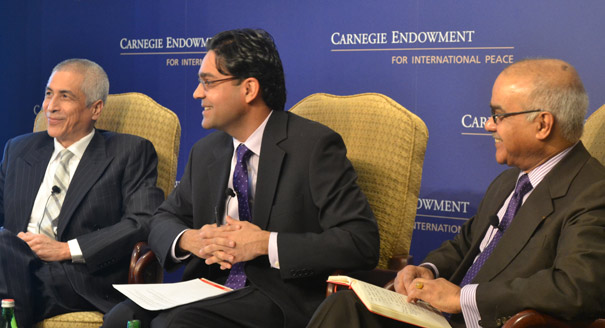Registration
You will receive an email confirming your registration.
India enacted the Mahatma Gandhi National Rural Employment Guarantee Act (MGNREGA) in 2005 to implement an ambitious, demand-driven employment-creation program through projects that improve agricultural productivity and alleviate land degradation. It has achieved impressive results, but the act continues to pose immense design and management challenges. Eduardo Zepeda, the co-author of a new report on the act entitled Employing India, and Selim Jahan of the United Nations Development Programme discussed the progress and challenges of the employment scheme. Carnegie’s Milan Vaishnav moderated.
MGNREGA at a Glance
- Returns on Investment: Zepeda identified some of the employment scheme’s major achievements, including providing employment aimed at developing assets and infrastructure to fifty million rural households. In so doing, MGNREGA has made significant strides in reducing poverty, stress migration, and malnutrition.
- A Modest Investment: Spending on MGNREGA accounts for 0.6 percent of India’s GDP, a level that Zepeda termed quite moderate in comparison to similar programs in other developing countries. But the goal of providing each household with at least one hundred days of employment per year remains a long way off, Zepeda added.
- Philosophical Underpinnings: Zepeda and Jahan both emphasized that MGNREGA takes a rights-based approach to employment, distinguishing it from some other social safety net programs such as conditional cash transfers (CCT).
- Local Control: MGNREGA is implemented largely at the community level, with local gram sabhas (autonomous community councils) recommending projects for program support. Ideally, Zepeda said, this policy helps promote employment without artificially impacting labor markets.
Key Findings
Employing India’s economic analysis is based on two simulation models, Zepeda said. The first model assumes a moderate expansion of job creation under MGNREGA, while the second forecast assumes an increase in land productivity. Jahan noted that this distinctive joint approach to assessing the employment scheme’s performance helps assess both its macro- and microeconomic impacts in more robust detail than many previous analyses.
- Job Creation: Zepeda explained that further job creation boosts most macroeconomic indicators, including GDP, but that his team’s simulations indicated lower individual consumption statistics. The rural poor would see significant gains in household welfare under this scheme, but urban and educated households would experience a slight dip in relative welfare as demand falls and the Indian government imposes some new taxes.
- Increasing Productivity: Increased land productivity similarly improves macroeconomic variables, Zepeda said, but tends to favor higher-income and urban households in terms of microeconomic performance.
Next Steps
- Scalable and Reproducible: Jahan remarked that the government of India is anxious to determine whether MGNREGA can be expanded further, especially given criticism that the program suffers from leakage and corruption. Other countries in the developing world, he added, are looking closely at MGNREGA as a model for similar programs of their own.
- Give Reforms a Chance: While Zepeda agreed that concerns about corruption and other flaws in MGNREGA are valid, he urged Indian policymakers to gradually reform the program, rather than attempt a major overhaul to the largely successful current approach.
- What About Cash Transfers? Especially as Pakistan continues an ambitious conditional cash transfer program, Jahan said that he would welcome a comprehensive study comparing the costs and benefits of CCT CCT and employment schemes. While Jahan believes that a well executed employment program is likely to be more effective on balance, he noted that CCT initiatives boast lower administrative costs and may promote larger investments in families and children.
